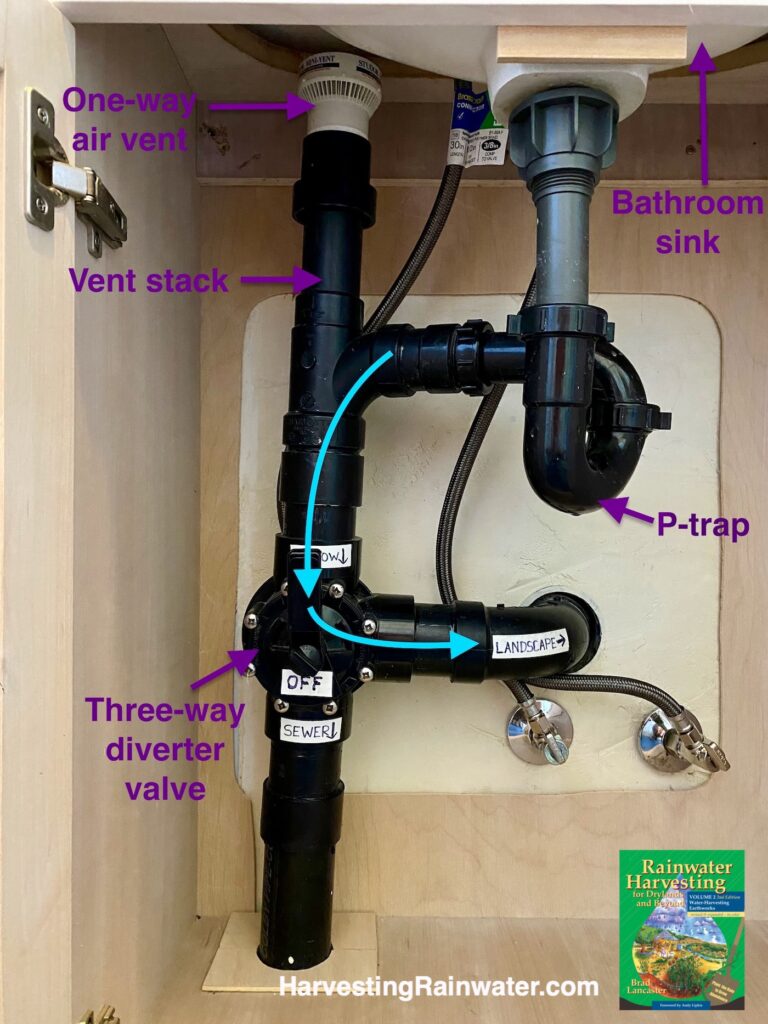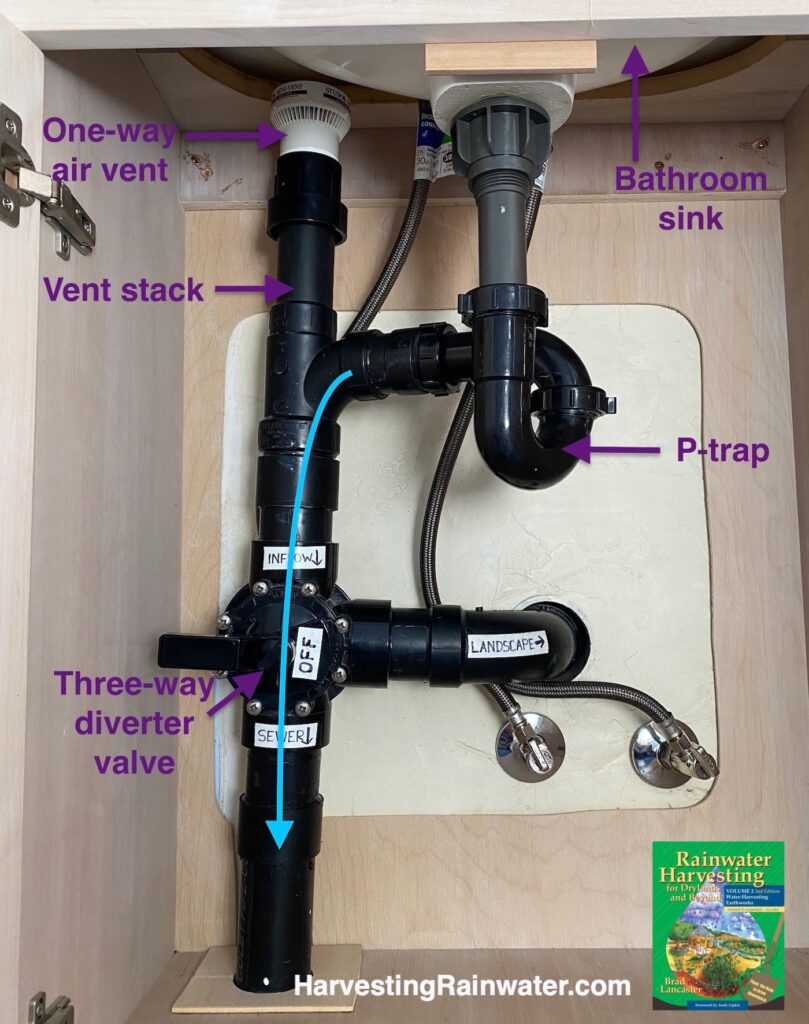Common 3-way diverter valves, such as Jandy and Pentair, now approved for permitted residential greywater-harvesting systems
by Brad Lancaster, HarvestingRainwater.com
For over three decades common high-quality three-way diverter valves, such as Jandy Valve and Pentair, made for swimming pools and spas, have been used with great success in pioneering residential greywater-harvesting plumbing across the United States and Canada, whereby the valves allow homeowners, residents, and guests to conveniently direct gravity-fed household greywater from sink, shower, and bath drains to either the landscape (for free irrigation of plants) or sewer/septic depending on what goes down the drain or how wet the soil is outside.

Jandy-brand three-way diverter valve allows resident to direct greywater from this bathroom sink greywater to landscape, as is the case in this image, or sewer/septic —depending on what goes down the drain or how saturated the soil is outside.
Blue arrow denotes greywater flow.
Plumbing in photo is in cabinet beneath the bathroom sink.
Photo: Brad Lancaster
BUT sometimes plan reviewers have NOT allowed, or permitted, the use of these valves because they were not tested and listed as “drain, waste, and vent” piping.
No effective and affordable valves in the U.S. are.
However, these valves ARE tested, and listed, for higher performance conditions, such as pressurized swimming pool and spa systems.
When the use of these valves were rejected for greywater-harvesting systems, the associated greywater-harvesting system was often removed from the project, sometimes at the recommendation of the building department, resulting in less water conservation, more waste, and less resilient water infrastructure (the opposite of the intent of water-conservation measures such as the City of Tucson greywater-harvesting stub-out ordinance)
But thanks to a new Administrative Policy 2024.01E, the City of Tucson has corrected this!
See here for the policy.
And this can be used as a template to change policy in other municipalities and counties (they will be much more comfortable making such changes upon seeing how another municipality did it).
Making the case
See here for the written and illustrated case we (Brad Lancaster and architect Valerie Lane) made to the City of Tucson, while working with City of Tucson building official Clayton Trevillyan to change city policy, and allow these valves to be used in permitted greywater-harvesting systems.
See here for some of the testimonials I gathered from across the country from people living with, and using, the three-way diversion valves we were seeking to have approved by the city of Tucson.
(I’ve removed the contact info here of those who submitted testimonials, but made this available to the building officials with the permission of those who submitted their testimonials).
Many thanks to all of you who responded to me with written testimonials and photos — they made a big difference in opening city officials’ eyes to how common and extensive the use of these valves are in greywater-harvesting applications, and how they’ve been successfully used this way for decades.
We also had a number of meetings with city of Tucson officials, and kept city council members updated with our process.
A quirk in the policy
Note that Administrative Policy 2024.01E states,
“The orientation of valve installation may not restrict the flow when the diverter is set to discharge to the public sewer. This may require adjusting the inlet of the valve so that flow passing through the valve does not change direction when the valve is set to discharge to the public sewer.”
This IS achieved with the orientation of the valve in the image below:

Blue arrow denotes greywater flow.
Photo: Brad Lancaster
I have found that such an orientation of the valve is not necessary for the system to work well (myself and colleagues have done numerous installations with different successful orientations of the valve), but this is what the new city of Tucson administrative policy currently asks for to permit the use of these valves.
The fact that we can now permit systems with these valves is a big step forward.
And perhaps a few years down the line, once more inspectors and builders become more familiar and comfortable with these valves, we can revisit and evolve the policy further.
It’s a process, and I’m thankful the City of Tucson has been willing to work with us in this process.
For more three-way diverter valve installations see here.
For more free greywater-harvesting resources see here.
For some of the greywater-harvesting plumbers & landscapers I know, see here.
Big thanks to greywater-harvesting pioneer Art Ludwig, who exposed many of us to the advantages of these valves in his books Branched Drain Greywater Systems and Create an Oasis with Greywater.
And for still more info, strategies, tips, case studies, ways of changing policy, and how-to — see the greywater-harvesting chapter and dark-greywater-harvesting appendix in Rainwater Harvesting for Drylands and Beyond, Volume 2, 2nd Edition by Brad Lancaster
See the new, full-color, revised editions of Brad’s award-winning books
– available a deep discount, direct from Brad:

Volume 2
For more information on various gravity-fed greywater-harvesting systems; and how to place, design, size, implement, and plant them in balance with BOTH your soil’s percolation rate AND your greywater discharge to acheive maximum positive effect:
• Read this book’s greywater chapter and its dark greywater harvesting appendix (3)
